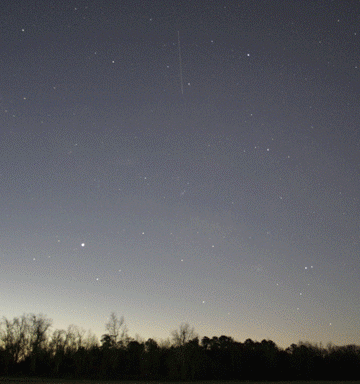| Where's Saturn? Is that a UFO--or the ISS? What's the name of that star? Get the answers from mySKY--a fun new astronomy helper from Meade. | |  | HEART NEBULA: Far, far away, 7500 light years from Earth, there's a Valentine waiting for pickup. Astrophotographer John Chumack framed it in the eyepiece of his 4-inch telescope and offers this high-resolution snapshot for anyone who needs a lovely desktop background. "It's the Heart Nebula, also known as IC 1805," he explains. "I thought readers of Spaceweather.com might like it on Feb. 14th." Happy Valentine's Day! SPY SATELLITE: Doomed spy satellite USA 193 has been in the news lately because of expectations that it will reenter Earth's atmosphere in March and turn into a spectacular fireball. Reentry has not yet begun, but sky watchers are already noticing the satellite as it zips over Europe and the United States. Friedrich Deters sends this movie from LaGrange, North Carolina: 
Click to view the complete movie
The clip shows USA 193 rounding the horizon at dawn on Feb. 10th. "This was the first time I could see the decaying spy satellite," says Deters who photographed it using his Canon Rebel XT. "Too bad I couldn't witness it actually entering the atmosphere; looks like it's traveling pretty quick!" In fact, USA 193 may never reenter--at least not in one piece. Today, the Pentagon announced plans to blast the satellite with a missile before its orbit completely decays. This would lessen the chances of dangerous satellite debris and fuels reaching the ground while increasing the population of space junk in low-Earth orbit. Would you like to see USA 193 with your own eyes? It is about to make a series of evening appearances over many US towns and cities, beginning this weekend and continuing until the Pentagon intervenes. Flyby timetables may be found at Heavens Above. You can also receive telephone and email alerts when the satellite is about to fly over your backyard by subscribing to Spaceweather PHONE. more images: from Becky Ramotowski of Tijeras New Mexico LOWER SUN PILLAR: A gust of wind on a freezing day can hurl stinging crystals of ice into the air and right ... at ... you. Open your eyes! Those painful crystals may be creating a beautiful display. On such a day last week in Quebec, this sun pillar appeared in midair before photographer David Swan: 
"The temperature was -29C and the air was filled with tiny ice crystals," says Swan. Plate-shaped crystals fluttering nearly parallel to the ground reflected the overhead sun and spread its rays into a luminous column of light. "This pillar came from crystals that were so close, some of the individual motes are visible in the photo!" Now that didn't hurt so much, did it? more images: from Mike Conlan skiing down Whistler Mountain, British Columbia, Canada | 
